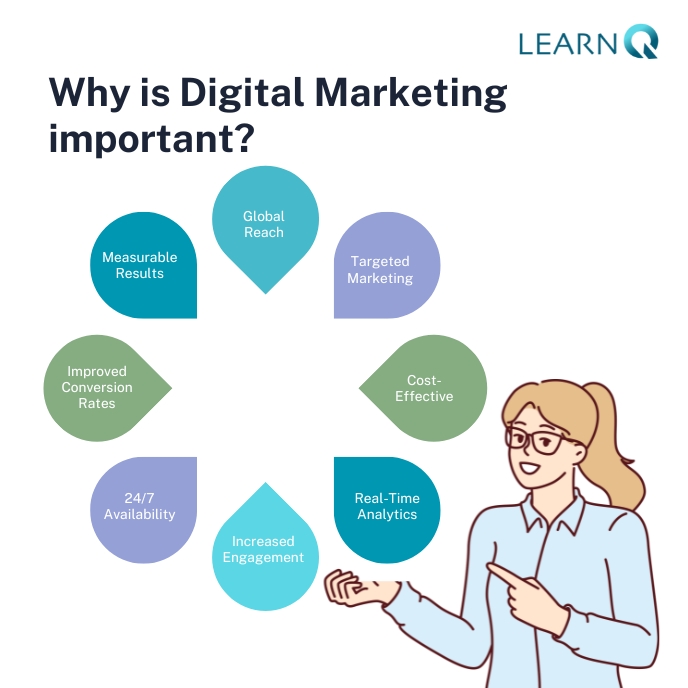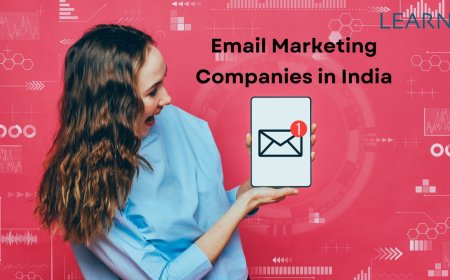Businesses have changed a lot because of the Internet. Digital marketing is all about using the internet to promote products and services. It includes lots of different strategies and ways to get people interested in what you offer. Digital marketing uses things like search engines (like Google), social media sites (like Facebook), and emails to connect with potential customers. At the heart of digital marketing are two big ideas: Search Engine Optimization (SEO) and Search Engine Marketing (SEM). These are all about making sure your website shows up when people search for things online. Then, there's content marketing, social media marketing, email marketing, and PayPerClick (PPC) advertising. These are ways to make people notice your brand and get them involved.
Digital advertising is another big part of this. It's about using the internet to show ads to specific groups of people. By looking at how well these ads work, businesses can figure out what's effective and what's not, and adjust their strategies accordingly. A good digital marketing plan includes both ways to bring people in (inbound marketing) and ways to reach out to them (outbound marketing). It's all about finding the best ways to meet the goals of your business. As more and more people spend time online, having a strong digital presence is crucial for making sure people recognize and stick with your brand.
Understanding SEO Fundamentals
businesses must make sure they can be easily found online. That's where Search Engine Optimization (SEO) comes in. SEO is all about making your website more visible on search engines like Google. This guide covers everything you need to know about SEO, from the basics to more advanced strategies, in easy-to-understand terms.
Getting Started with SEO
1. Find the Right Keywords: Start by figuring out which words and phrases people are using to search for businesses like yours. This will help you know what to focus on when optimizing your site.
2. Optimize Your Pages: Make sure each page of your website is set up in a way that makes it easy for search engines to understand what it's about. This includes things like using the right keywords in your titles, headings, and content.
3. Get Other Sites to Link to Yours: Having other reputable websites link to yours can help improve your site's credibility and make it more likely to show up higher in search results.
4. Use Tools to Track Your Progress: There are lots of tools available that can help you see how well your SEO efforts are working. These tools can tell you things like how many people are visiting your site and which keywords are bringing them there.
Taking Your SEO to the Next Level
1. Create Great Content: Producing high-quality content that people want to read or watch is a key part of SEO. This can include things like blog posts, videos, and infographics.
2. Focus on Local Searches: If your business serves a specific area, make sure you're optimizing your site for local searches. This might include claiming your Google My Business listing and getting positive reviews from local customers.
3. Make Your Site Mobile-Friendly: With so many people using smartphones to search the web, it's important to make sure your site looks good and works well on mobile devices.
4. Optimize for Voice Search: More and more people are using voice-activated devices like smart speakers to search the web. Optimizing your site for voice search can help you reach these users.
Advantages of content marketing
In digital marketing, content marketing is important for businesses. It helps them get noticed online and connect with people who might be interested in what they offer. Content marketing is all about creating useful and interesting stuff like blogs, videos, or social media posts that people want to see. One great thing about content marketing is that it can help a business show up higher in search results on websites like Google. This means more people might see their website when they're searching for something related to what the business offers. It also works well with paid ads on search engines, making those ads more effective.
1. Increased Brand Awareness: When you regularly share content that your audience likes, more people learn about your brand and recognize it.
2. Enhanced Customer Engagement: Good content makes people interact with your brand more, which means they become more loyal customers.
3. Improved Search Engine Visibility: If your content is good and uses the right keywords, Google ranks your website higher, so more people find you online.
4. Lead Generation and Conversion: Content marketing helps attract new customers by addressing their problems and guiding them to buy your products or services.
5. CostEffectiveness: Compared to traditional ads, content marketing is cheaper and gives you more value for your money in the long run.
Content Distribution Channels
1. Social Media Platforms: Share your content on Facebook, Twitter, LinkedIn, and Instagram to reach more people.
2. Email Newsletters: Send your content directly to your subscribers' inboxes through email newsletters.
3. ThirdParty Publications: Write guest posts for websites related to your industry to reach a wider audience and build credibility.
Making the Most of Social Media Marketing
Using social media for marketing is important. It helps businesses connect with people, make them like the brand, and grow. Platforms like Facebook, Instagram, Twitter, and LinkedIn have billions of users, giving businesses a big chance to reach out to them and talk in real time.
Key Strategies for Success
1. Set Clear Goals: Decide what you want to achieve with social media, like getting more people to know your brand, getting more people to visit your website, or selling more stuff.
2. Know Your Audience: Learn who your audience is, what they like, and how they act online. This helps you make content they'll enjoy.
3. Pick the Right Platforms: Focus on the social media sites where your audience hangs out the most.
4. Make Great Content: Create interesting posts, videos, or pictures that your audience will love. Mix it up so it doesn't get boring.
5. Talk to Your Followers: Respond quickly when people comment or message you. It helps build a community around your brand.
6. Try Paid Ads: Spend some money to reach more people or target specific groups with ads on social media.
7. Keep Track of Your Progress: Look at how well your posts are doing. Use the data to make your social media better.
Best Practices
-
Post regularly to keep your followers interested.
-
Show the human side of your brand by sharing stories or showing what happens behind the scenes.
-
Get your audience involved by asking them to share their content or join in on fun activities.
-
Keep up with trends to stay current.
-
Make sure your social media profiles and posts show up in search results.
Maximizing Your Reach: The Power of Social Media Marketing (SMM)
where connectivity knows no bounds, social media platforms have become more than just avenues for personal expression. They have transformed into powerful tools for businesses to engage with their audience, build brand awareness, and drive conversions. Welcome to the realm of Social Media Marketing (SMM), where strategic utilization of online platforms can propel your business to new heights. Platform-specific strategies lie at the core of effective social media marketing. Each platform be it Facebook, Instagram, Twitter, LinkedIn, or TikTok comes with its unique features and user demographics. Crafting tailored content and engagement tactics for each platform ensures maximum resonance with your target audience. For instance, visually appealing content thrives on Instagram, while concise, witty messaging gains traction on Twitter.
Social media advertising emerges as a pivotal component of SMM. With the ability to precisely target specific demographics, interests, and behaviors, platforms like Facebook Ads and Instagram Ads offer unparalleled reach and engagement potential. Strategic allocation of advertising budgets coupled with compelling ad creatives can yield impressive ROI (Return on Investment) for businesses of all sizes. Community management plays a crucial role in fostering meaningful relationships with your audience. Promptly responding to queries, addressing concerns, and actively participating in conversations demonstrate your brand's commitment to customer satisfaction. Building a loyal community not only enhances brand trust but also generates valuable word-of-mouth referrals.
The Power of Email Marketing: Strategies for Success
Email campaign planning and execution are the cornerstones of successful email marketing. Crafting compelling content, defining clear objectives, and strategically timing your campaigns can maximize their impact. Moreover, leveraging tools for Email list building and segmentation ensures that your messages resonate with the right audience, driving higher open and clickthrough rates. Email automation streamlines the process, allowing you to deliver personalized messages at scale, while A/B testing and optimization enable continuous improvement by identifying what resonates best with your audience. Additionally, prioritizing Email deliverability and compliance safeguards your sender's reputation and ensures your emails reach the intended inboxes.
PayPerClick (PPC) Advertising
Pay-per-click (PPC) Advertising is a powerful tool for businesses looking to get noticed online, attract visitors, and make more sales. It's really important to understand and use PPC well if you want to keep up with other businesses. Let's talk about PPC advertising in simple terms. There are different places where you can put up ads online. One big place is Google Ads. They offer different types of ads like Search, Display, Video, and Shopping ads. Google Ads is great because it helps you target the right people and reach a lot of them. Another place is Bing Ads, which is like an alternative to Google Ads. Social media is also a big player in PPC advertising. Platforms like Facebook, LinkedIn, and Twitter let you create ads that target specific groups of people. This is cool because you can connect with users in a more personal way. When you're making ads, it's super important to write them in a way that gets people's attention and makes them want to click. This means researching what words people are searching for and writing persuasive messages.

Making the Most of Mobile Marketing: Tips for Success
Almost everyone uses smartphones all the time. For businesses, this means they've got to get smart about mobile marketing to connect with people effectively and stay competitive. One big part of mobile marketing is promoting mobile apps. Many apps are out there, so you need a plan to stand out. That means things like making sure your app looks good in app stores, using social media to spread the word, and getting influencers to talk about it.
Another important thing is making sure your website looks good and works well on phones and tablets. This is called responsive design, and it's super important for keeping people happy and making sure your site shows up in search results. Sending text messages to customers is still a great way to get their attention. If you can personalize the messages and make them interesting, you'll probably see more people buying your stuff. Location-based marketing is pretty cool too. It uses where people are to send them ads or offers for nearby businesses. It's a smart way to reach people who might be interested in what you're selling. And don't forget about ads. There are lots of different places to put ads on phones, like in apps or on social media. If you pick the right places and make ads that people actually like, you can reach a lot of potential customers.
E-commerce Marketing Success
Online selling, and having good marketing plans are super important to do well. If you use the right strategies, you can make your online store successful. So, let's talk about the important parts of e-commerce marketing, from making your website better to keeping customers coming back for more. Making sure your e-commerce platform is easy to use is the first step to success. If your website works well, people will like using it, and that means more sales for you.
Putting your products in the best light is also really important. That means having great descriptions and awesome pictures that make people want to buy them. Sometimes, people put things in their cart but then don't buy them. You can try sending them emails or offering them special deals to get them to finish their purchase. Once someone buys from you, you want to keep them coming back. Offering things like loyalty programs or suggesting other products they might like can help with that. Lastly, looking at data about your sales and customers can help you understand what's working and what's not. This way, you can make smart decisions to grow your business.
Understanding Marketing Analytics and Data Interpretation
Using marketing data is important for businesses. It helps them do better than their competition. Let's talk about some important things about marketing data and how it helps businesses.
-
Website Tracking: Websites like Google Analytics give useful information about who visits your site, like how many people come, who they are, and what they do there. This helps you make your website better.
-
Important Numbers to Track: Certain numbers show how well your marketing works. Keeping an eye on these helps you make good choices based on facts.
-
Finding Out Where Customers Come From: Figuring out which ads or campaigns make people buy stuff helps you spend your money smarter.
-
Understanding How Customers Shop: Knowing the steps people take before buying something helps you make your marketing fit what they want.
-
Testing Different Ideas: Trying out different things in your marketing helps you see what works best, so you can do more of that.
Digital Marketing Strategy and Planning: Key Steps to Success
In online marketing, having a solid plan and clear goals is super important for businesses to stay ahead. From deciding what you want to achieve to making it happen, every step matters. Let's break down the important parts of making a great digital marketing plan:
1. Setting Goals:
-
Figure out exactly what you want to achieve and make sure it's something you can measure.
-
Use the SMART method (Specific, Measurable, Achievable, Relevant, Timebound) to keep things clear and focused.
2. Knowing Your Audience:
-
Learn about the people you want to reach – their age, interests, and what they like.
-
Split them into groups based on what they have in common, then tailor your messages to each group.
3. Checking Out the Competition:
-
Look at what other businesses similar to yours are doing online.
-
Figure out what they're good at and where they might be falling short.
-
Use what you learn to make your plan even better.
4. Planning Your Budget:
-
Decide how much money you can spend based on what you want to achieve.
-
Spread your money out across different ways of reaching people online.
-
Keep an eye on how well things are working and be ready to change things up if you need to.
5. Planning Your Campaign and Timeline:
-
Make a detailed plan that shows what needs to happen and when.
-
Make sure everyone on your team knows what they're supposed to be doing.
-
Keep track of how things are going and be ready to make changes if you need to.
Trends and Technologies in Digital Marketing
In digital marketing, businesses need to keep up with what's happening. Things change fast, and if you want to stay ahead, you need to know about the latest trends and tools. Let's take a look at some of the exciting things going on in the world of digital marketing.
Voice Search Optimization:
-
More and more people are using virtual assistants like Siri and Alexa to search for stuff. So, businesses need to make sure their websites can be found using voice searches.
-
This means tweaking how they do SEO to match the way people talk when they're asking questions.
Artificial Intelligence and Machine Learning Applications:
-
AI and machine learning are like supersmart helpers for marketers. They can crunch big piles of data, personalize content for customers, and even predict what people might want to buy next.
-
By automating some of the boring stuff, AI lets marketers focus on the fun parts of their job, like coming up with cool ideas.
Augmented Reality (AR) and Virtual Reality (VR) in Marketing:
-
AR and VR are changing the game by letting brands create cool, immersive experiences for customers.
-
Imagine being able to try on clothes virtually or seeing how furniture would look in your house before you buy it. That's the kind of stuff AR and VR can do for marketing.
Chatbots and Conversational Marketing:
-
Have you ever chatted with a bot online and felt like you were talking to a real person? That's because chatbots are getting really good at providing instant help and even suggesting products you might like.
-
This kind of conversational marketing makes it easier for businesses to build trust and keep customers happy.
Blockchain in Digital Advertising:
-
Blockchain is like a super secure digital ledger that keeps track of transactions. In digital advertising, it helps prevent fraud and makes sure everyone gets paid what they're owed.
-
With smart contracts, advertisers and publishers can trust that they'll get what they agreed on without any funny business.
Digital marketing is a really important tool for businesses nowadays. It helps them reach lots of people, make content that feels personal, and see how well their marketing is doing. This is super helpful for businesses of any size. As technology keeps getting better, digital marketing strategies will too. But some things will always stay important, like telling good stories, knowing your audience, and using data to make decisions. When companies embrace digital marketing, they can stay competitive, build strong relationships with their customers, and grow in a world that's becoming more digital.





































